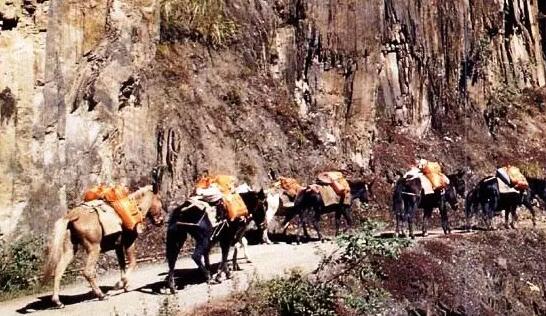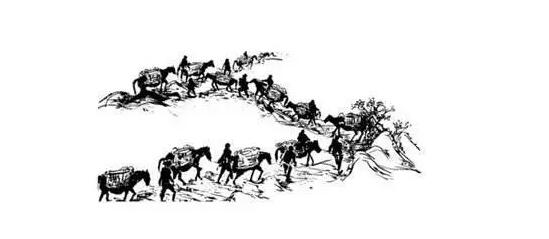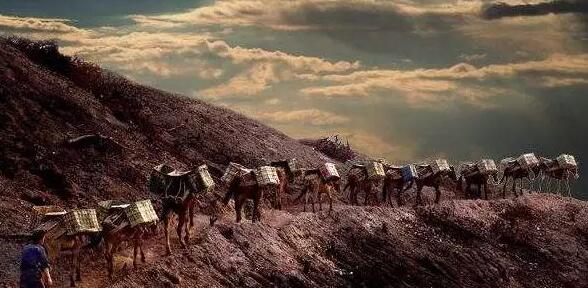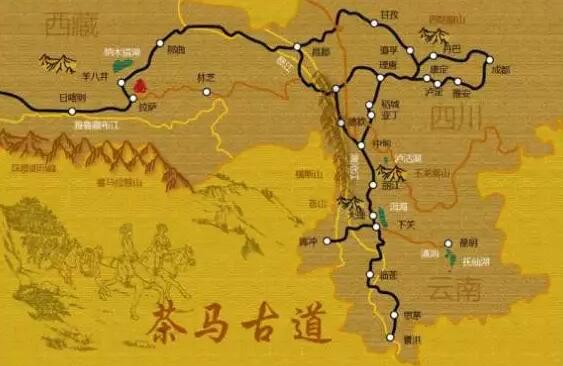Tea Horse Road

Tea Horse Road is a folk international trade channel that existed in the southwestern region of China, with horse caravans as the main means of transportation. It is a corridor for economic and cultural exchanges among ethnic groups in Southwest China. The Tea Horse Road is a very special regional term, a tourism route with the most spectacular natural scenery and the most mysterious culture in the world, with a total length of nearly 4,000 kilometers and a history of more than 1,300 years. It has profound historical accumulation and cultural heritage, serving as an indispensable bridge and link between ancient Tibet and the inland. It contains endless cultural heritage and has long-standing historical and cultural significance.

Historical Exploration
According to historical records, the earliest overseas spread of Chinese tea can be traced back to the Northern and Southern Dynasties. At that time, Chinese merchants exchanged goods for tea at the border adjacent to Mongolia, exporting tea to Turkey.
During the Sui and Tang Dynasties, with the development and expansion of border markets and the opening of the Silk Road, Chinese tea was transported to West Asia, North Asia, and Arab countries through the Uighurs and other regions in the form of tea-horse trade, passing through Siberia and finally reaching Russia and Europe.

Starting from the Tang Dynasty, successive rulers actively adopted measures to control the tea-horse trade. From the first year of the reign of Emperor Suzong of Tang (756 AD) to the first year of the Qianlong era, the tea-horse trade was initiated in the Uighur region of Mongolia, marking the beginning of the tea-horse trade.
During the Northern Song Dynasty, the tea-horse trade mainly took place in the Shaanxi and Gansu regions, with the tea for horse trading sourced locally from Sichuan and administered by tea and horse trading offices in Chengdu and Qinzhou (now Tianshui, Gansu).

During the Yuan Dynasty, the government abolished the tea-horse border control policy implemented in the Song Dynasty.
In the Ming Dynasty, the post station system of the Yuan Dynasty was continued, and damaged sections were required to be restored within a time limit. At the same time, the Ming Dynasty strengthened the management of key crossings and ferries on the post roads. The Ming Dynasty established tea-horse trading offices in Yazhou and Diaomen, with millions of kilograms of tea entering Tibet through the Kham region each year. The Sichuan-Tibet route, as the main "tea road," saw a significant increase in economic value. During the Hongwu era of Emperor Taizu of Ming, a top-quality horse could be exchanged for up to 120 catties of tea. During the Wanli era of the Ming Dynasty, it was stipulated that a top-quality horse could be exchanged for 30 baskets of tea, a medium-quality horse for 20, and a lower-quality horse for 15. The Ming Dynasty writer Tang Xianzu wrote in his poem "Tea Horse": "How beautiful the black tea is, how special the Qiang horses are." "Qiang horses and yellow tea, the Hu horses seek gold and pearls." This reflects the prosperity of the tea-horse trade market at that time.
By the Qing Dynasty, the tea-horse border control policy had relaxed, with many private tea merchants emerging, resulting in more tea being spent and fewer horses being obtained in the tea-horse trade. In the 13th year of the Yongzheng era of the Qing Dynasty, the official tea-horse trade system was terminated.
The tea-horse border control trade system lasted from the Sui and Tang Dynasties to the Qing Dynasty, spanning nearly a thousand years of vicissitudes. During the long years of the tea-horse market trade, Chinese merchants used their own feet to tread a rugged and winding Tea Horse Road on the northwestern and southwestern frontiers.
Due to social unrest, wars, corruption in the Qing government, and other reasons, the Tea Horse Road was abandoned along with the rapid decline of the Pu'er tea industry.

Origin of the Name
In the summer of 1990, Professor Mu Jihong of Yunnan University and others arrived in the triangular area of Sichuan, Yunnan, and Tibet to verify the existence of the Tea Horse Road and conduct some academic research along the way.
During this journey, they endured various unexpected challenges and faced the danger of death at any time. In the caves of the deep mountains and under the steep rocks, piles of bones reminded them of the difficulty of traveling this road. In the end, they spent more than three months walking over 2,000 kilometers, crossing dozens of large snow-capped mountains over 4,700 meters high, and traversing dozens of rapids and dangerous rivers such as the Jinsha, Nu, and Lancang Rivers. They conducted a systematic investigation of the language and culture in the large triangular area of Yunnan, Tibet, and Sichuan, collected and recorded nearly a million words of data, took more than 3,000 documentary photos, recorded hundreds of tapes of folk stories and music, and collected thousands of physical specimens.
At the end, they named this vast network of ancient roads in Asia, connected by tea, the Tea Horse Road.
Historical Significance
With the rise of modern transportation, this Tea Horse Road, which had played an important role in connecting the Han and Tibetan peoples since the Tang and Song Dynasties for over a thousand years, has lost its former status and function. However, as a historical witness to the formation of the Chinese nation and as a precious historical and cultural heritage of the large family of Chinese ethnic groups today, it still shines brightly, and its significance and value become increasingly prominent with the passage of time.
The four words "Tea Horse Road" have allowed Pu'er tea to emit a cultural fragrance from the nearly obliterated dust of history.
Over more than two hundred years, with the changes of dynasties and the rise and fall of human affairs, the Tea Horse Road has always witnessed the changes in the history of Pu'er tea. The Tea Horse Road has ultimately become the soul of Pu'er tea culture!